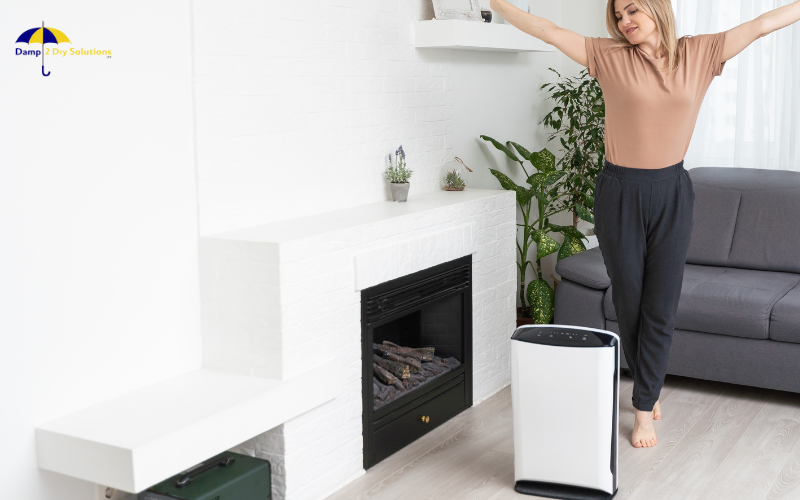
Basements and crawl spaces might not always be the first areas you think about in your home, but they are absolutely vital when it comes to maintaining the building’s structural integrity.
However, these hidden spaces are often vulnerable to excess moisture, which can cause a range of problems, from damp and mould to musty odours and even damage to your property. Ignoring them can lead to costly repairs, so it’s essential to keep these areas dry and protected.
In this guide, we’ll explore the benefits of dehumidifiers, how to choose the best one for your basement or crawlspace, and answer common questions to help you make an informed decision.
Why You Need a Basement Dehumidifier
Basements are particularly susceptible to high humidity. A dehumidifier specifically designed for this environment is essential to managing moisture, preventing mould, and protecting your property. These units are built to handle larger spaces and higher humidity levels than standard home dehumidifiers, making them ideal for basements and crawlspaces.
However, if you’re facing significant moisture problems, it might be time to consider professional waterproofing. Damp 2 Dry Solutions Ltd offers basement waterproofing services that can eliminate the root cause of your moisture issues, ensuring long-term protection and peace of mind.
Key Benefits of Basement Dehumidifiers
Dehumidifiers offer several important benefits for basements and crawlspaces:
- Mould Prevention: Maintaining optimal humidity levels keeps walls, furniture, and carpets dry, preventing the growth of mould.
- Structural Protection: They prevent moisture damage to your home’s structural components, safeguarding its integrity.
- Improved Air Quality: Dehumidifiers help reduce allergens, improving air quality throughout the home.
- Enhanced Comfort: By removing musty odours, these appliances make your basement or crawlspace a more comfortable environment.
If you’re considering converting your cellar into a functional living space, look no further than Damp 2 Dry Solutions Ltd. Their cellar conversion services not only eliminate damp but also allow you to repurpose your basement into an extra bedroom, home office, or entertainment area.
How to Choose the Right Dehumidifier for Your Basement
Selecting the right dehumidifier for your basement is essential to maintain optimal humidity levels, prevent mould, and protect your home. Follow these steps to choose the best unit:
1. Measure the Size of Your Basement
The first step is to measure the square footage of your basement, as this will determine the capacity your dehumidifier needs. Dehumidifiers are rated in pints per day (PPD), indicating how much moisture they can remove from the air in a day. Here’s a general guideline based on basement size and humidity levels:
- Small basements (up to 1,500 square feet) with moderate humidity: 30-40 PPD unit.
- Medium basements (1,500 to 2,500 square feet) with moderate humidity: 40-50 PPD unit.
- Large basements or those with high humidity: 50-70 PPD or more.
2. Choose a Drainage Method
Dehumidifiers come in two types: standard models and those with built-in pumps. The drainage method should suit your basement’s layout. Common options include:
- Manual Emptying: Some models collect water in a tank that needs to be emptied regularly.
- Gravity Drainage: Continuous drain tubes allow water to be removed automatically through a drain or sink using gravity.
- Condensate Pump: Dehumidifiers with built-in pumps provide more flexibility, allowing water to be pumped vertically or horizontally into a sink or drainage system. This is ideal if the drain is located higher than the dehumidifier.
3. Consider the Built-in Humidistat
A humidistat allows you to set your preferred humidity level, and the dehumidifier will automatically cycle on and off to maintain it. This feature is essential for consistent humidity control. Ensure the unit you choose has a reliable digital humidistat for precise control.
4. Look for Energy Efficiency
Energy efficiency is crucial, as dehumidifiers tend to run continuously in basements. Choose an Energy Star certified unit, which will save you money on electricity bills. Look out for units with the Energy Star Most Efficient certification for even greater energy savings.
5. Check the Noise Level
If you spend time in the basement, consider the noise level of the dehumidifier. Quieter models, typically measured in decibels (dB), are more suitable for spaces where you might want peace and quiet.
6. Basement Dehumidifier Air Filtration

A dehumidifier with a built-in air filtration system offers an added benefit for your basement. These filters trap dust, allergens, and airborne particles, helping to purify the air while the dehumidifier reduces humidity.
This is particularly helpful for households with allergy sufferers or pets, as it improves overall indoor air quality. Look for units with washable or replaceable filters for easy maintenance. HEPA filters are especially effective, capturing fine particles that can trigger allergies and asthma.
By choosing a model with a good air filtration system, you not only control humidity but also make your basement a healthier environment.
7. Portability and Mobility
If you need to move your dehumidifier around, look for models with wheels for easy manoeuvrability. This is particularly useful for large basements or when addressing specific problem areas.
8. Maintenance
Keeping your dehumidifier in good working order is key to its long-term effectiveness. Choose a model with easily accessible filters and removable water tanks to make maintenance as simple as possible.
Removable and washable filters should be cleaned regularly to ensure they don’t become clogged with dust or debris, which can reduce the unit’s efficiency. For units with a water tank, ensure it’s easy to empty and clean.
Auto-clean functions or filter replacement indicators can be handy features to look out for, ensuring you stay on top of maintenance without any hassle.
9. Brand and Warranty
Invest in a reputable brand with a strong track record for reliability and durability. Check for warranty details and read customer reviews to ensure you’re making a sound investment.
10. Set a Budget
While it’s important to set a budget, remember that investing in a high-quality, energy-efficient dehumidifier will save you money in the long run through lower energy costs and reduced maintenance.
Additional Tips for Reducing Basement Humidity
Even the best dehumidifier won’t be fully effective if there are issues with water seepage or standing water in the basement. Here are a few extra steps to manage basement humidity:
- Extend downspouts away from the foundation of your home.
- Keep gutters and downspouts clean.
- Ensure the soil around your home slopes away to prevent water pooling.
- Avoid over-watering plants near the foundation.
- Vent clothes dryers outside.
- Use vent fans in bathrooms and kitchens to remove humidity.

For more significant waterproofing issues, you can rely on the professional services of Damp 2 Dry Solutions Ltd. Our team offers expert waterproofing and water damage restoration services to ensure your basement remains dry and protected from future problems.
Whether you’re looking to resolve persistent moisture issues, convert your basement into a liveable space, or restore water-damaged areas, Damp 2 Dry Solutions Ltd is your trusted partner in creating a safe, dry, and comfortable environment. For more information about our services, contact us today.
